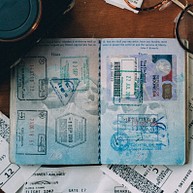
-
![red taxi in front of the train station in San Jose]() Provided by: Guanlong D./cc by 2.0/Flickr (cropped)
Provided by: Guanlong D./cc by 2.0/Flickr (cropped) -
![red taxi in Costa Rica]() Provided by: Guanlong D./cc by 2.0/Flickr (cropped)
Provided by: Guanlong D./cc by 2.0/Flickr (cropped)

Our travel guides are free to read and explore online. If you want to get your own copy, the full travel guide for this destination is available to you offline* to bring along anywhere or print for your trip.
*this will be downloaded as a PDF.Price
€4,95
Taxi
The guide was updated:Taxis in San José usually have a meter and are inexpensive. Official taxis are coloured in red or orange, and one km costs about 640 colones. It is strongly recommended to only use official taxis and make sure that the meter is ticking. Alternatively, use Uber or Didi. Note that exact street names are hardly used in Costa Rica so you better refer to some well-known places nearby.
As in many countries in Latin America, you want to know who is driving you so that they are less likely to scam you or drive off with your belongings. For your safety, do not take regular taxis — call for one or use a ride sharing app.
Useful Information
- Website: ticotimes.net/2021/09/19/taxis-costa-rica-ultimate-guide
Digital Travel Guide Download
Our travel guides are free to read and explore online. If you want to get your own copy, the full travel guide for this destination is available to you offline* to bring along anywhere or print for your trip.
*this will be downloaded as a PDF.Price
€4,95

The best time to visit Costa Rica is during the dry season, from mid-December to April — you'll get plenty of sunshine, ideal for exploring beaches. The forests, however, are not as lush this time of the year. The dry season is the most crowded and expensive time to visit.
The rainy season lasts from May to November, with incessant rain showers — it is the cheapest season to visit. During June and July, rain showers stop briefly and the forests burst with green foliage.
Read more

Passport / Visa
Costa Rica allows for visa-free travel periods up to 90 days to citizens from most EU, America, and Oceania countries. Before traveling, check Costa Rican visa requirements that apply to citizens on your country.
Read more

Addresses
San José and other towns in Costa Rica use a rectilinear roadway grid. The roads going north and south are called calles (streets) while the ones going east and west are called avenidas (avenues).
Let's pretend that Calle Central is number 0. From there, calles count up by odd numbers to the east and even numbers west. Avenidas have odd numbers north of the pedestrian Avenida Central and even going south. Parque Central and Mercado Central (Central park and market) are usually at the centre of town.
Many addresses will be written down as Calle 4, Avenidas 4 & 6 — somewhere on the north-south street 4 between avenues 4 and 6.
However, many businesses will describe their location in relation to major landmarks. For example, Dulce Junio Café's address is "200 m Este De la Iglesia Santa Teresita y 25 norte, contiguo a Saúl Bistro, Barrio Escalante, San José" — that's 200 m from the Santa Teresita church and 25 m north, next to Saúl Bistro, Escalante neighbourhood.
Read more

Aeropuerto Internacional Juan Santamaría (SJO)
The Juan Santamaría International (SJO) airport is located about 17 km northwest of the city centre. Right outside the entrance, you will find local shuttle buses that take you downtown. The journey is usually inexpensive. If you prefer taxis, make sure to get a licensed "Taxi Aeropuerto". One journey is about 25 minutes and costs about 25 US$.
The most common bus you’ll see is the big red TUASA bus. The final stop of this bus is close to La Merced park.
Read more

Public Transport
There is a good and inexpensive bus system in San José, as well as outbound buses to the rest of the country. Interbus and Gray Line Fantasy Bus will also take you to touristic places outside the city centre, but the fares are slightly more expensive.
If you are taking a bus between cities, be very mindful of your belongings. The bags are often stolen from overhead luggage racks. If anyone is trying to help you put your bag up there — they are very likely to grab it and leave at some point. If they go for your bag and you try to stop them, that's when you will be pickpocketed by their accomplices.
Read more

Taxi
Taxis in San José usually have a meter and are inexpensive. Official taxis are coloured in red or orange, and one km costs about 640 colones. It is strongly recommended to only use official taxis and make sure that the meter is ticking. Alternatively, use Uber or Didi. Note that exact street names are hardly used in Costa Rica so you better refer to some well-known places nearby.
As in many countries in Latin America, you want to know who is driving you so that they are less likely to scam you or drive off with your belongings. For your safety, do not take regular taxis — call for one or use a ride sharing app.
Read more

Post
There are several post offices spread throughout San José. One of the main branches is located on Via 204.
The Telegraph and Post Office building dates all the way back to 1917 and is located close to La Merced park (officially known as Braulio Carrillo Colina Park).
Read more

Pharmacy
There are three major chains of pharmacies in Costa Rica that sell medicine as well as personal hygiene products:
Fischel
In front of the Correos de Costa Rica (Central Post Office), San José, plus many other locations in the country.
+506 2248 1682
Farmacia Sucre
Plaza de la Democracia, the Sauter building, on the corner of Calle 11 Avenida Central
+506 2248 9302
Farmacia La Bomba
Calle 1, Avenida Central, close to the Pre-Columbian Gold Museum
+506 4001 3647
Read more

Telephone
Country Code: +506
Area Code: 22
Read more

Electricity
Costa Rica uses 110 volt, 60 cycle electricity. The plugs are typically the 2-pronged flat type common in North America and some Asian countries.
Read more



